I have spent most of my working life writing, and can write most things, from news to features to press releases to books. I tailor my style to fit the magazines I work for, so some is sensible, and some is slightly less so. What follows are short excerpts from various magazines in which I've been published.
From Rouleur magazine:
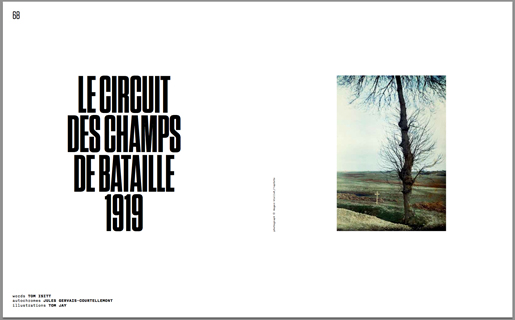
THE TOUGHEST RACE
In 1919, a stage-race across the battlefields of the Western Front saw astonishing feats of endurance as riders picked their way across a landscape devastated by four years of war. This is the story of the Circuit Cycliste de Champs de Bataille.
Lecomte took a lantern from a hook by the door, and stepped outside. Pulling his hat down against the flurries of sleet and rain borne by a biting north-easterly gale, he peered into the night. Nothing. No sign. Where the hell were they? They should have been here hours ago. He lifted the lantern, as if hoping its modest glow would summon the riders from the gloom. Still nothing.
Returning to the light and warmth of the Café de L'Est, Lecomte stamped his feet and shrugged off his thick overcoat. "Il pleut encore," he muttered to his fellow commissaires, gathered around a table near the fire. Degraine checked his pocket-watch and wondered, not for the first time, whether this race really was such a good idea.
That idea, the seven-stage Circuit Cycliste de Champs de Bataille (roughly translated as The Tour of The Battlefields), was intended to reinvigorate bicycle racing in France, Belgium and Luxembourg after WW1, and to honour those who had died on those battlefields. Tour de France champions Lucien Petit-Breton, Francois Faber and Oscar Lapize were just three of 67 pro riders "morts pour la France". Countless other less well-known riders perished in that conflagration, and still lie beneath Flanders' fields.
...
A metre of snow fell on Northern Europe in late April that year, turning pavé to ice and unmade roads to a slippery quagmire. Considering their primitive bikes, lack of food, and woefully inadequate clothing (wool shorts and a long-sleeve wool jersey), it’s astonishing that any of the riders continued.
Albert Dejonghe won the second stage in appalling conditions, and 30 minutes later the spectators were treated to the extraordinary sight of Charles Deruyter pedaling across the finish line wearing a full-length woman's fur coat, which some kindly soul had lent him to keep out the cold.
Starting at 4.30am from Brussels, and expected in Amiens at 3pm, Stage 3 saw the riders race across the battlefields of Ypres, Artois, and the Somme. Scarcely five months after hostilities ended, the parcours required the riders to negotiate 323km of this brutalised land in temperatures barely above freezing. One commentator was moved to describe the race as “inhuman”.
What can have been going through their minds as they rode through the ruins of the Menin Gate in Ypres, negotiated Hell Fire Corner and struggled up the Menin Road, past the vast mine crater at Hooge and the blasted remnants of Sanctuary Wood? Away to the right, Messines Ridge, to the left, the pile of shattered bricks that once was Passchendaele. Half a million men fought and died in these "fields".

Tormented by hunger and cold, they pedaled on. Either side of the muddy roads the detritus of war was everywhere - twisted tree stumps, fields long since obliterated by shelling, concrete bunkers, mine and shell craters, wrecked gun carriages, clothing, bones. All around, belts of wire, trenches and duckboards zig-zagged in all directions, and hastily-erected crosses littered the landscape. And still the sleet and rain fell. And still the wind blew, unchecked by trees or hedgerows...
From France magazine:
Tour de Corse
There can be few places in Europe as wild and mysterious as Corsica. Tom Isitt went exploring
Sitting in the sun, warming your back against a large slab of cyclopean masonry and looking out over the Pianu de Levie, you could be at any point in time over the last 4000 years. A walk through a thick oak and chestnut forest brings you eventually to this mysterious, magical place perched on a small hill overlooking the rolling countryside of central southern Corsica.
Even the name, Cucuruzzu, sounds ancient and shrouded in the mists of time. Here you can sit, untroubled by any evidence of the 21st Century, or even the 19th or 15th Centuries. It could be 1000BC. The only sound is the wind rustling the trees, and bird song. There are no electricity pylons visible, or roads, or vapour trails in the sky. There is a timeless peace about this place. To the north-east the jagged peaks of the Col de Bavella are obscured by clouds. There are occasional signs of human habitation…a dry-stone wall, what looks to be a settlement on the side of a hill away to the north…but the wild and unspoiled nature of this landscape is breath-taking.
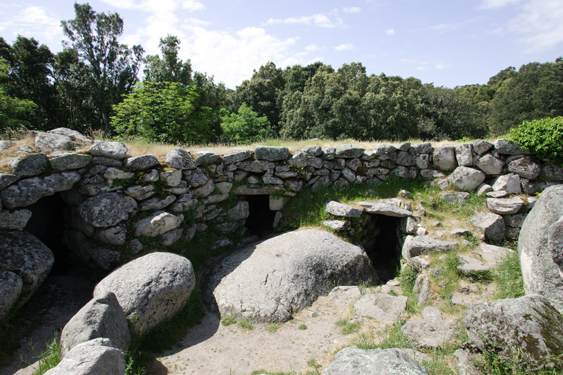
There can be few places left in western Europe where you get this emptiness without a hostile environment to go with it. Generally, if you want peace and solitude, away from the madding crowd, you need to be several thousand metres above sea level in the mountains or the inhospitable wildernesses of Scandinavia. But southern Corsica is hospitable, yet curiously deserted. But is wasn’t always so. In prehistory, this area was relatively densely populated, with many places such as Cucurruzu dotted throughout the landscape. And many of them are still visible in this extraordinary landscape of southern Corsica.
The emptiness of this part of the world is curious, given that southern Corsica is blessed with all the ingredients for a booming tourist trade. There are fabulous beaches, picturesque villages, stunning scenery and a warm, reliable climate. Mercifully (for visitors keen to get away from it all), Corsica has kept a lid on tourist development, so there are no gigantic concrete hotels or swathes of identikit holiday villas. Instead you chose between beach-side campsites or small family-run hotels in the towns and villages.
And so on...
From Sports Boat & RIB:
JUST SAY NO!
In which Tom Isitt experiences a series of unfortunate events at the London Boat Show, mostly involving alcohol and industrial-strength prescription medicines.
It wasn’t supposed to be like this. It was supposed to be an endless round of Champagne, quail’s eggs, air-kissing and small gifts from grateful marine companies. By rights, I should have been over-refreshed and face-down in some PR girl’s cleavage by mid afternoon on Preview Day. Instead I was drenched in sweat, shaking like a leaf, and feeling somewhat unusual.
If Ken Russel had directed Narnia, shot it in a huge shed in East London heated to 95°C and full of boats, and you’d watched it from the middle of a vast lime-flavoured jelly after dropping a tab of LSD, you’d be getting quite close to my London Boat Show experience.
No problem, I thought to myself…just a slight cold. Maybe I’ll lay off the Champagne and concentrate on trying to preserve the thin veneer of professionalism that I have tried to make my own. So, no sloe gin, no devils-on-horseback, no Guinness, no Tanqueray. Just strong coffee, cameras and notebook at the ready, and a purposeful dash around the Show attending various product launches, shooting atmosphere photos, and generally being a freelancer on a mission to bring you the definitive Boat Show report.
Transcribing my notes several days later, and looking at the pictures I took, it is apparent that I wasn’t well. A trifle odd, you might say. For one thing, I seem to have been at the wrong Show. I have garbled notes and photographs of some bloke ballroom-dancing, of stands selling sheds, cookery equipment, loft insulation, Jacuzzis, gazebos and cars. I’ve also got photographs of scantily-clad angels, a female peacock (that can’t be right, surely?), a red seaweed lady, and three blokes who appear to be 20ft tall and covered in burnished gold.
Over the first weekend of the Boat Show the “slight cold” turned into a vicious chest-infection, an inability to breathe, and a slightly blue face. By Sunday morning I was hooked up to a machine at my local hospital breathing a mixture of oxygen and nandrolone (or something).
Not to worry, I thought to myself as I left A&E several hours later lugging a skip-full of industrial-strength antibiotics and weapons-grade steroids, I’ll just pop into the chemist and get some strong painkillers, and it’ll all be fine for Monday’s return to the Show.
Oh dear.
Apparently, mega-doses of steroids have the amusing side-affect of causing you to grow big hairy man-breasts, but frankly that was the least of my worries. Uncontrollable shaking, a core temperature of 197°C, and very erratic behaviour are also on the list. Which is probably how I came to be locked in the boot of a Honda Accord in the North Hall of ExCeL while my three children fell about laughing. The hilarious prank of locking dad in the boot of a Honda was made even funnier by the fact that the boot could not be opened again, even by the staff on the Honda stand, because the battery had been disconnected.
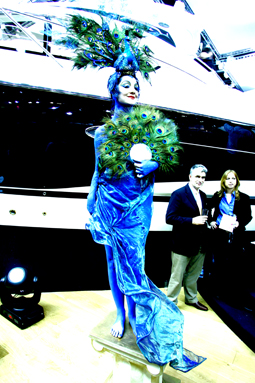
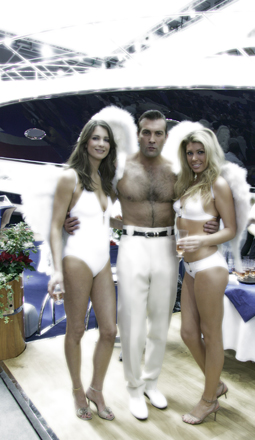
The good news was that huge doses of prescription antibiotics, steroids and painkillers took the edge off the Show, without me ever feeling the need to lie down or throw up. Mix your pharmaceuticals to keep your karma suitable, and all that. Yes, I was a bit wired, but hey…I was getting the job done. I’d looked at some new boats, I’d bought 17 T-shirts on the Weird Fish stand, I’d slipped seamlessly into the Ideal Home Show, and I’d seen Brian Ferry wearing nothing but a pair of white strides and some feathery wings. Despite having all the ingredients for a 24-carat gold-plated, Olympic-sized, mink-lined, ocean-going balls-up, it was all working out quite well. Admittedly it was better when I let the kids take the photos, and their notes made a lot more sense than mine.
There's more, but that's probably enough!
BE COOL
Admiral launched a new 35 metre planing yacht last summer that features some truly unique design touches. Tom Isitt went a board this extraordinary yacht.
There can’t be too many boats around that have big wide oak floorboards throughout the two main decks, or that embrace an eclectic style of contemporary design quite so willingly. But Be Cool, the new 35 metre yacht launched under the Admiral name by Cantiere Navali Lavagna a few months ago, is one such boat.
In fact there are probably very few boats around that reflect the owner’s taste quite so uniquely and unselfconsciously as Be Cool. The owner, a successful Italian businessman, got his architects (Studio Magazzini Associates in Rome) to liaise with the CNL designers, and the results are extraordinary. Eclectic doesn’t even begin to describe the finished product. It’s a kind of Manhattan-loft-meets-gentleman’s-club-with-a-splash-of-Scandinavian-design.
And while this astonishing mixture of styles tells you something about the owner, it also gives little away about him. Take the dining room. The owner is evidently comfortable mixing an ultra-modern brushed-aluminium dining table with classic arts and crafts style Thonet dining chairs, albeit ones with a thoroughly modern white lacquered finish. And in the saloon the owner has mixed rustic wooden floorboards with traditional chesterfield furniture, titanium wall panels and a very modern ceiling and lighting arrangement. You can tell the owner is fearless, but you struggle to get a sense of his own personal style.
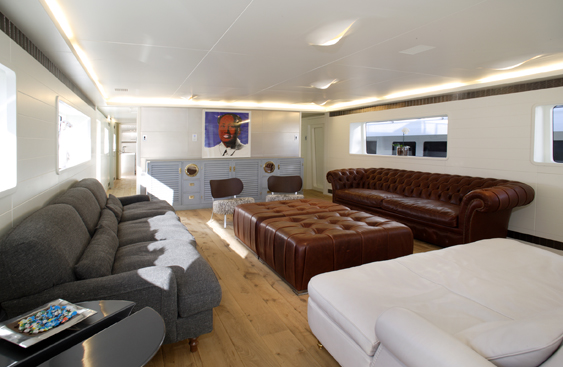
However, between the owner, his architects, and Admiral’s design team, they’ve created a quite extraordinary boat. With a deep-vee hull designed by Studio Bagicalupo and made from 5083 aluminium-alloy, Be Cool is designed to be fast as well as comfortable. Certainly a design speed of 30 knots, and a cruising speed of 28 knots, is pretty respectable for a conventionally-powered 35 metre boat. “Be Cool is a planing yacht in which elegance and performance combine to give its owner the maximum on-board comfort,” explained Maurizio Magri, commercial director of CNL.
The exterior lines and interior layouts are sharp and contemporary, the result of a collaboration between CNL’s design team and Studio Luca Dini Design (the people who are also responsible for Tecnomar hulls). Talking about his design philosophy, Luca Dini maintains it is important to design “interiors with a good head height everywhere, the minimum number of drops possible, lots of privacy for everyone, spacious exteriors, and galleys that are really functional”. The hull is “oyster white”, but the superstructure is a metallic silver/grey, which give the boat a distinctive two-tone look not unlike that of a ’60s Austin Healey.
You get the picture...
And another from Boat International:
ARCTIC DREAMS
Tom Isitt discovered the joys of heli-cruising when he joined MY Akula on the last leg of a trip to Greenland and the Canadian Arctic.
Standing on the sundeck, swaddled against the near-freezing night temperatures of the Canadian Arctic in early autumn, we experienced one of those magical, life-affirming moments. Above, the Northern Lights danced and shimmered, and away in the distance, across the water, wolves howled their primeval lament. It was a moment of pure wonderment, and it was by no means to be the last on this trip. Very few people get to experience the unimaginable vastness of the Canadian Arctic. This huge, seemingly empty landscape is on a scale which few of us can even conceive. The roar and thunder of a nearby waterfall, and the soft buffeting of the wind, are the only sounds. The nearest town is 150 miles to the south, and the nearest “road” is over 300 miles away. Here, in Saglek Fjord on the northern Labrador coast of Canada, there is nothing. And nobody. Nobody, that is, except for the polar bears, seals, black bears, wolves, peregrine falcons, lemmings, arctic foxes, ptarmigan, arctic hare, and caribou. In the streams there are arctic char, and in the open water there are Minke whales, Beluga whales, lots of icebergs, and more whales.
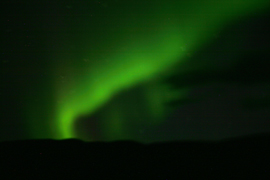
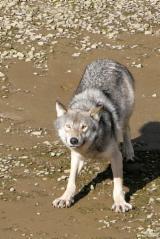
The foreboding greyness of the fjord and its icy waters belies the abundance of plant and animal life. Look closely, and a myriad of colours can be seen amongst the stones — lichens of the brightest green and orange; fire-red succulents growing in the lee of a small boulder; blueberry and mountain cranberry bushes, heavy with fruit, hugging the ground; moss the colour of emeralds, spongy under foot; puffs of arctic cotton clustered around a low-lying pool. The fecundity of this land is surprising, and delightful, and for those of us from Europe or the US, the unfamiliar rhythms of Arctic life are confusing and enchanting in equal measure.

This huge, untamed wilderness with its soaring peaks and ice-scoured valleys, seems worlds away from the cruising grounds we have become accustomed to, but it is nearer than you might think. It is common practice for yachts to spend their winters in the Caribbean and their summers on the east coast of the US. However, rather than stopping at The Hamptons or Rhode Island, if you were to continue north for a few days you come to Nova Scotia and Newfoundland. Another few days cruising and you come to the north Labrador coast and the Torngat Mountains National Park. It really is that accessible, yet the Canadian National Parks department estimate that fewer than 300 visitors a year come to this magical place which looks rather like a cross between the Scottish highlands and Yosemite National Park.
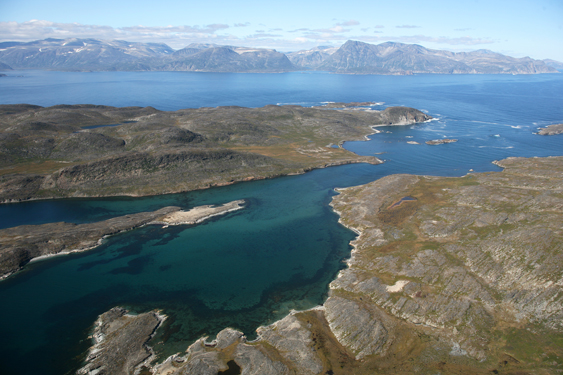
There's a lot more, but you probably get an inkling of my various "styles" from the above